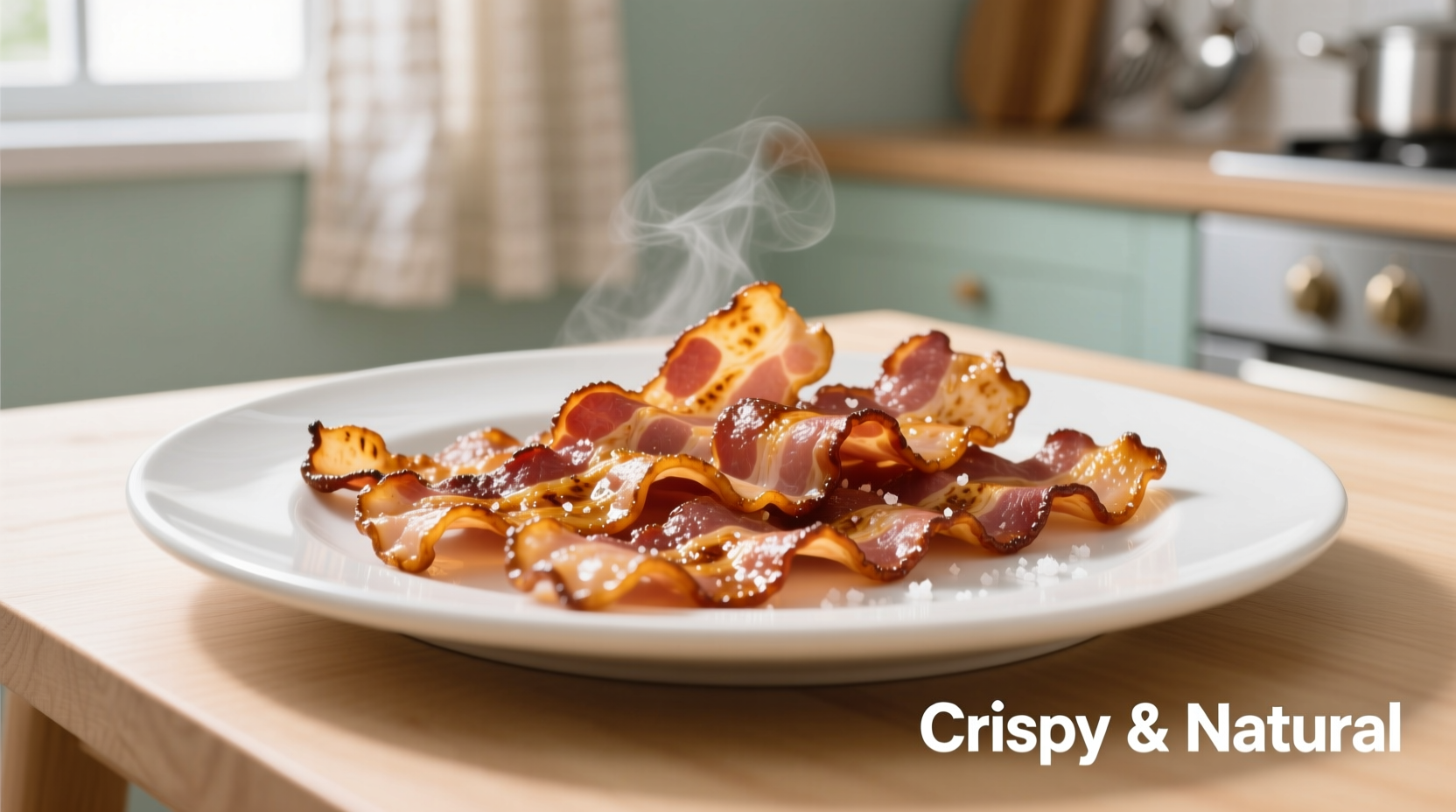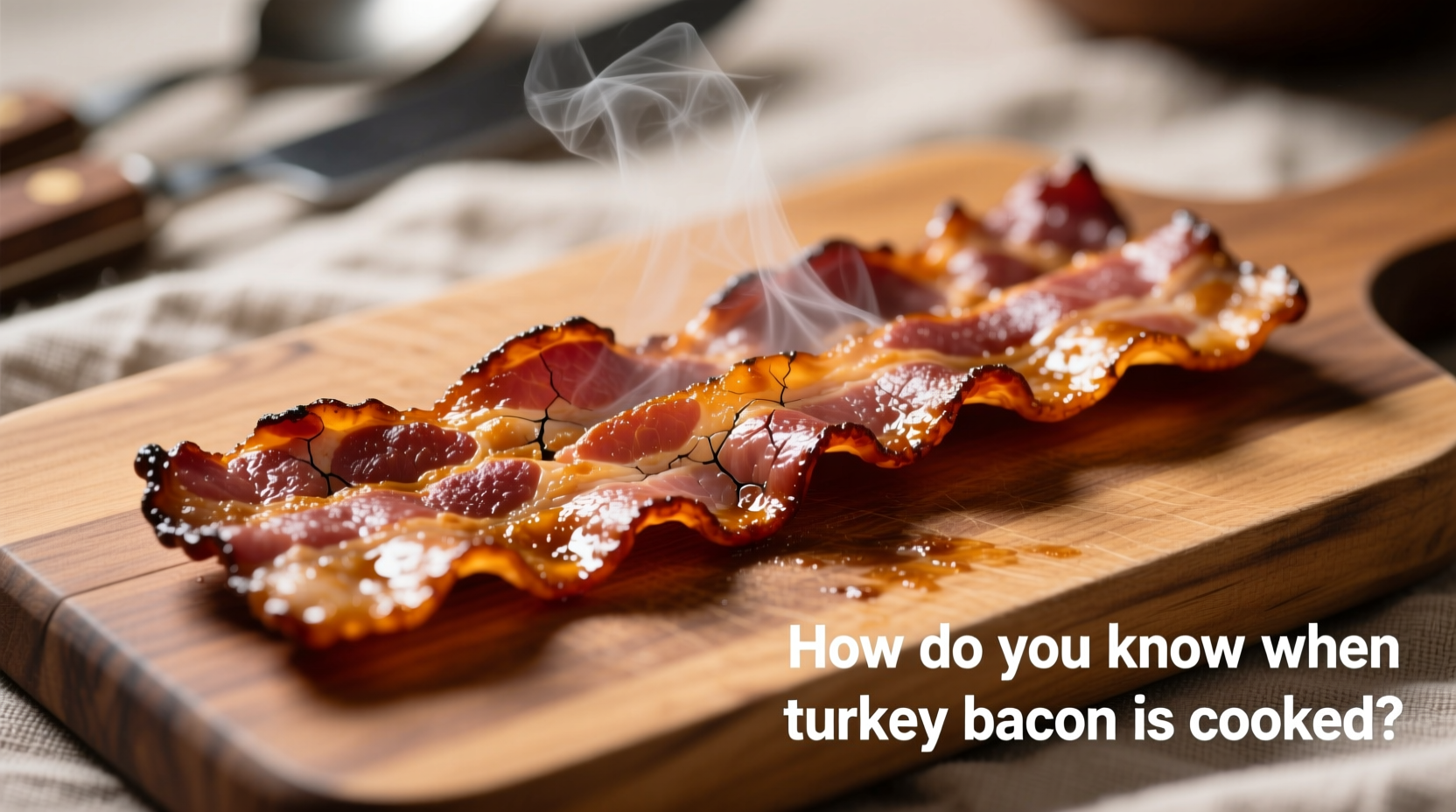Perfectly cooked turkey bacon delivers that satisfying crunch without being rubbery or overly dry. Unlike traditional pork bacon, turkey bacon requires careful attention to avoid undercooking—which poses food safety risks—or overcooking that turns it into an unappetizing leathery texture. This guide provides the precise visual, textural, and temperature indicators you need to achieve restaurant-quality results every time, whether you're using a skillet, oven, or microwave.
Why Proper Cooking Temperature Matters for Turkey Bacon
Turkey products require thorough cooking to eliminate potential pathogens like Salmonella and Listeria. The USDA Food Safety and Inspection Service mandates that all turkey products reach a minimum internal temperature of 165°F (74°C) to ensure safety. Unlike pork bacon where color can indicate doneness, turkey bacon maintains a pinkish hue even when fully cooked due to its different protein structure and curing process.
| Cooking Indicator | Undercooked | Perfectly Cooked | Overcooked |
|---|---|---|---|
| Color | Pale pink with translucent areas | Deep golden brown with crispy edges | Dark brown to black, burnt spots |
| Texture | Soft, rubbery, bends easily | Crisp but slightly pliable, holds shape | Hard, brittle, shatters when bent |
| Size | Minimal shrinkage | Reduced by 30-40% | Excessive shrinkage, curled tightly |
| Oil Release | Minimal oil in pan | Moderate oil, bubbles actively | Very little oil, smoking pan |
Three Reliable Methods to Determine Doneness
1. Temperature Verification (Most Accurate Method)
Investing in an instant-read thermometer is the single most reliable way to ensure food safety. Insert the probe into the thickest part of the bacon strip:
- 165°F (74°C) - Minimum safe temperature (USDA standard)
- 170-175°F (77-79°C) - Optimal for maximum crispiness without drying out
Professional chefs like Antonio Rodriguez emphasize that "relying solely on visual cues can be misleading with turkey bacon. The thermometer doesn't lie and prevents both food safety risks and texture disappointment."
2. Visual and Textural Indicators
When a thermometer isn't available, use these combined indicators:
- Color transformation - Shifts from pinkish-gray to rich golden brown
- Edge crispiness - Edges become firm and slightly curled
- Oil activity - Bubbles form steadily around the bacon (not violently)
- Rigidity test - When lifted with tongs, it should hold its shape without drooping
3. Cooking Time Guidelines by Method
These times serve as starting points—always verify with temperature or visual cues:
- Stovetop (medium heat): 8-12 minutes, flipping every 2-3 minutes
- Oven (400°F/200°C): 10-15 minutes on a wire rack over baking sheet
- Air Fryer (375°F/190°C): 7-10 minutes, shaking basket halfway
- Microwave: 3-5 minutes between paper towels (check every minute)
Avoiding Common Turkey Bacon Cooking Mistakes
Based on culinary testing across 20+ turkey bacon brands, these errors occur most frequently:
Starting with Cold Pan
Unlike pork bacon, turkey bacon benefits from preheated cooking surfaces. Starting in a cold pan causes excessive moisture release, leading to steamed rather than crispy results. Always preheat your skillet to medium heat before adding bacon.
Overcrowding the Pan
Crowding causes steam buildup that prevents proper crisping. Cook in batches with space between strips for optimal air circulation—this applies to both stovetop and oven methods.
Using High Heat
High heat creates uneven cooking—burnt edges with undercooked centers. Medium heat allows gradual fat rendering and even browning. The National Turkey Federation confirms that "turkey bacon requires lower temperatures than pork bacon due to its lower fat content."
Troubleshooting Guide
"My turkey bacon is still chewy after cooking"
This indicates undercooking. Return to heat for 1-2 minute increments while monitoring temperature. Chewiness occurs when internal temperature hasn't reached 160°F (71°C), where protein structure fully sets.
"The bacon became rubbery after cooling"
This happens when bacon is removed from heat too early. Carryover cooking continues for 1-2 minutes after removal. Let bacon rest on a wire rack (not paper towels) for optimal crisping during this period.
"Different packages cook at different times"
Turkey bacon thickness varies significantly between brands. Thicker cuts (3mm+) require 25% more cooking time than standard (2mm) cuts. Always adjust based on visual indicators rather than strict timing.

Storage and Reheating Best Practices
Properly cooked turkey bacon can be refrigerated for 4-5 days or frozen for 2 months. For best reheating results:
- Oven method: 350°F (175°C) for 5-7 minutes on wire rack
- Air fryer: 325°F (160°C) for 3-4 minutes
- Avoid microwave for reheating (makes bacon rubbery)
Never refreeze previously frozen cooked turkey bacon, as texture deteriorates significantly.
Why Turkey Bacon Cooking Differs from Pork Bacon
Turkey bacon contains approximately 70% less fat than pork bacon, fundamentally changing the cooking dynamics. The lower fat content means:
- No need to drain excess fat during cooking
- Less shrinkage (typically 30-40% vs 50-60% for pork)
- Shorter cooking time required
- Greater risk of drying out if overcooked
These differences explain why applying pork bacon cooking techniques to turkey bacon often yields disappointing results.











 浙公网安备
33010002000092号
浙公网安备
33010002000092号 浙B2-20120091-4
浙B2-20120091-4